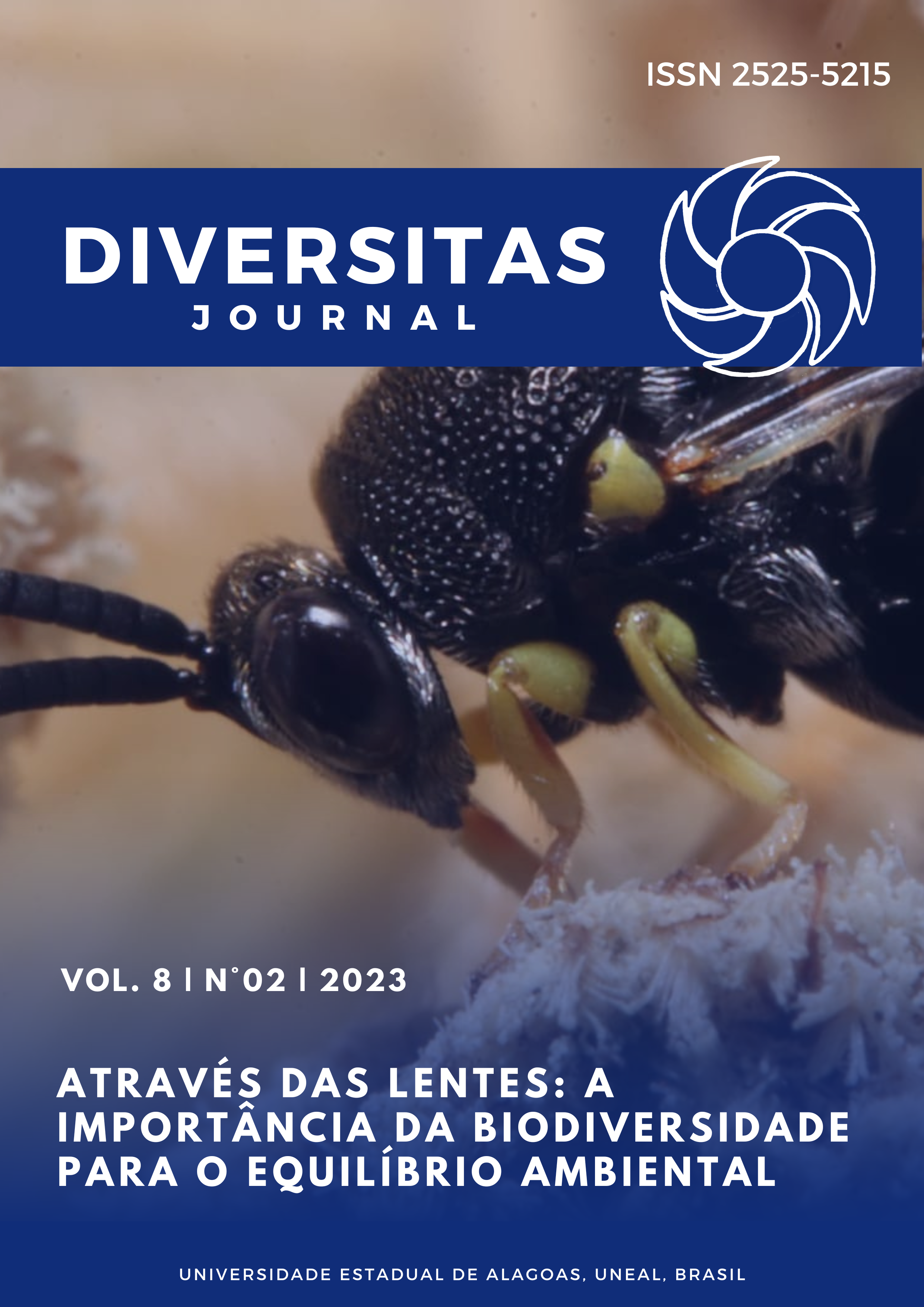Reproductive aspects in Ipomoea asarifolia (Desr.) Roem. & Schult. (Convolvulaceae) occurring in antropized caatinga area
DOI:
https://doi.org/10.48017/dj.v8i2.2513Keywords:
Morph variations, floral biology, salsa-bravaAbstract
Morphometry is a mechanism used to measure the differences among species from the study of the relationship between size and shape, creating comparative references, and allowing proper identification. The morphometric study aims to characterize different morphological types of an organism which, in turn, may present disproportionate growth, giving rise to a nonlinear relationship between these characteristics. This study aimed to analyze and describe possible reproductive variations in individuals of Ipomoea asarifolia, where floral structures were measured with the aid of a manual caliper, ruler and tapes, as well as equivalent photographs for laboratory morphometric evaluation. The study demonstrates the importance of research to understand the variation of floral morphs within a population, even if it is in an anthropized area because, although subtle, changes can alter the entire reproductive system.
Metrics
References
Azania, C. A. M., Gravena, R., Pavani, M. C. M. D., Pitelli, R. A. (2002). Interferência da palha de cana-de-açúcar (Saccharum spp.) na emergência de espécies de plantas daninhas da família Convolvulaceae. Scielo, v.20, n.2, p.207-212. https://doi.org/10.1590/S0100-83582002000200006
Barbosa, V. S. (2009) Influência de herbivoria de formigas cortadeiras no sucesso reprodutivo de espécies arbustivo-arbóreas da floresta atlântica nordestina. [Tese de doutoramento, UFPE]. Attena repositório digital da UFPE. https://repositorio.ufpe.br/handle/123456789/524.
Barrett, S. C. H. (1992) Heterostylous genetic polymorphisms: model systems for evolutionary analysis. In: M. Grossman, H. F. Linskens, P. Maliga, R. Riley (orgs), Monographs on Theoretical and Applied Genetics. (pp. 1-29). Springer Berlin.
Barrett, S. C. H., Shore, J. S. (2008) New insights on heterostyly: comparative biology, ecology and genetics. In: Franklin-Tong, V. E. (orgs), Selfincompatibility in flowering plants: evolution, diversity, and mechanisms. (pp. 3-32). Springer-Verlag, Berlin.
Barros, A. H. C., Filho, J. C. A., Silva, A. B., Santiago, G. A. C. F. (2012) Climatologia do Estado de Alagoas. Embrapa solos, p. 32. https://ainfo.cnptia.embrapa.br/digital/bitstream/item/103956/1/BPD-211-Climatologia-Alagoas.pdf.
Coelho, C. P. (2013) Sistema Reprodutivo, Distilia e Graus de Reciprocidade em Rubiaceae Arbustivas do Sub-Bosque de Formações Florestais do Cerrado. [Tese de doutoramento, UFU]. https://repositorio.ufu.br/handle/123456789/13274.
Ferreira, P. P. A., Miotto, S. T. S. (out./dez, 2009) Sinopse das Espécies de Ipomoea L. (Convolvulaceae) Ocorrentes no Rio Grande do Sul, Brasil. R. bras. Bioci., v. 7, n. 4, p. 440-453. http://www.ufrgs.br/seerbio/ojs/index.php/rbb/article/view/1229.
Flora do Brasil 2020. Jardim Botânico do Rio de Janeiro. https://reflora.jbrj.gov.br/refloral/PrincipalUC/PrincipalUC.do;jsessionid=19C4E0EA24ADEAFE76951DC2881165F1.
Kill, L. H. P., Ranga, N. T. (2004) Biologia da reprodução de Turbina cordata (Choisv) Austin & Staples (Convolvulaceae) no sertão pernambucano, Brasil. Sitientibus Série Ciências Biológicas. v. 4, pp. 14-19. https://ainfo.cnptia.embrapa.br/digital/bitstream/item/186746/1/Sitientibus-Serie-Ciencias-Biologicas-v.4-n.1-2-p.14-19-2004.pdf.
Kill, L. H. P., Ranga, N. T. (17, novembro, 2003) Ecologia da polinização de Ipomoea asarifolia (Ders.) Roem. & Schult. (Convolvulaceae) na região semi-árida de pernambuco. Acta bot. bras. v. 17, n. 3, p.355-362. https://doi.org/10.1590/S0102-33062003000300003.
Meira, M., David, J. M., David, J. P., Araújo, S. V., Regis, T. L., Giulietti, A. M. Queiroz, L. P. (2008) Constituintes químicos de Ipomoea subincana Meisn. (Convolvulaceae). Quím. Nova. v.31, n.4, p. 751-754. https://doi.org/10.1590/S0100-40422008000400007.
Paz, J. R. L., Pigozzo, C. M. (2012) Polinização de duas espécies simpátricas de Ipomoea L. (Convolvulaceae) em um remanescente urbano de Mata Atlântica, BA, Brasil. Naturalia. v. 35, p. 1-6. https://www.periodicos.rc.biblioteca.unesp.br/index.php/naturalia/article/view/6022.
Peres-Neto, P. R. (1995) Introdução a Análises Morfométricas. Oecologia Brasiliensis. v.2, p. 57-89. https://revistas.ufrj.br/index.php/oa/article/view/5554.
Silva, R. M., Sá, T. F. F., Cosolaro, H. (10-15, novembro, 2013) Biologia floral de plantas ornitófilas de sub-bosque em dois fragmentos urbanos no brasil central. 64º Congresso Nacional de Botânica, Belo Horizonte. https://dtihost.sfo2.digitaloceanspaces.com/sbo tanicab/64CNBot/resumo-ins18785-id1944.pdf.
Simão-Bianchini, R., Ferreira, P. P. A. (2015) Ipomoea in Lista de Espécies da Flora do Brasil. Jardim Botânico do Rio de Janeiro. http://floradobrasil.jbrj.gov.br/jabot/floradobrasil/FB70 21.
Sousa, M. A. N., Filho, E. F. S., Melo, N. J. A., Costa, E. L. (set-dez, 2014) Ipomoea asarifolia e seus efeitos tóxicos e genotóxicos em animais de produção. REVISTA SAÚDE E CIÊNCIA On line, v.3, n.3, p. 240-251. https://doi.org/10.35572/rsc.v3i3.328.
Downloads
Published
How to Cite
Issue
Section
License
Copyright (c) 2023 Mayane Luiza Alves Nunes, Genésio José do Amaral Ramos, Charlane Moura da Silva, Camila Chagas Coreeia

This work is licensed under a Creative Commons Attribution 4.0 International License.
The Diversitas Journal expresses that the articles are the sole responsibility of the Authors, who are familiar with Brazilian and international legislation.
Articles are peer-reviewed and care should be taken to warn of the possible incidence of plagiarism. However, plagiarism is an indisputable action by the authors.
The violation of copyright is a crime, provided for in article 184 of the Brazilian Penal Code: “Art. 184 Violating copyright and related rights: Penalty - detention, from 3 (three) months to 1 (one) year, or fine. § 1 If the violation consists of total or partial reproduction, for the purpose of direct or indirect profit, by any means or process, of intellectual work, interpretation, performance or phonogram, without the express authorization of the author, the performer, the producer , as the case may be, or whoever represents them: Penalty - imprisonment, from 2 (two) to 4 (four) years, and a fine. ”


















